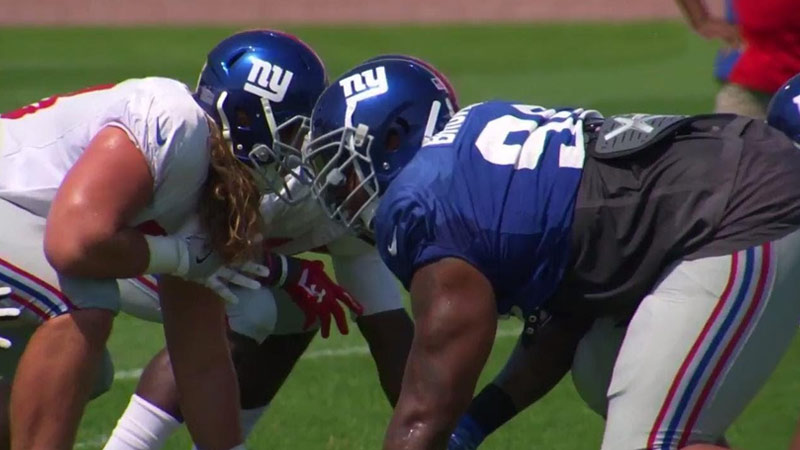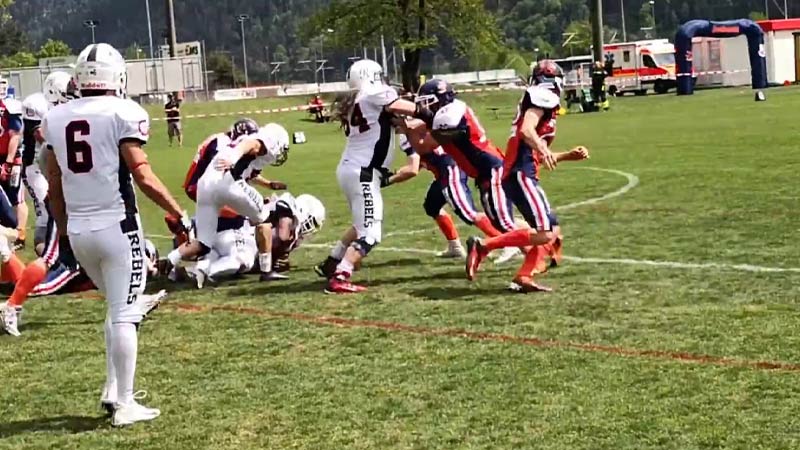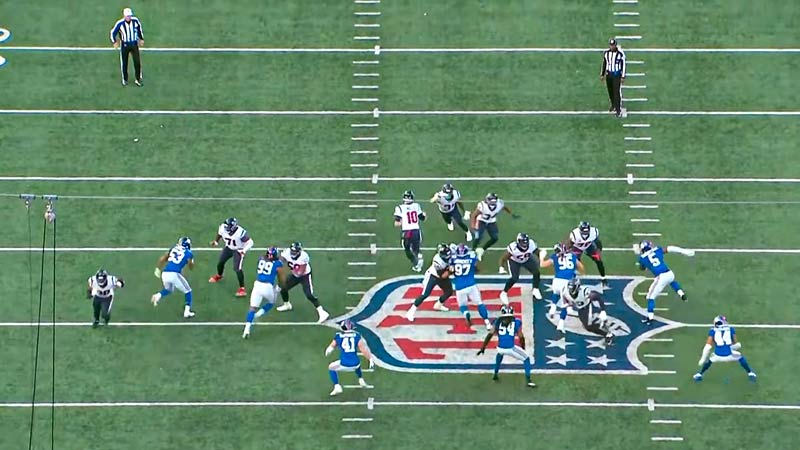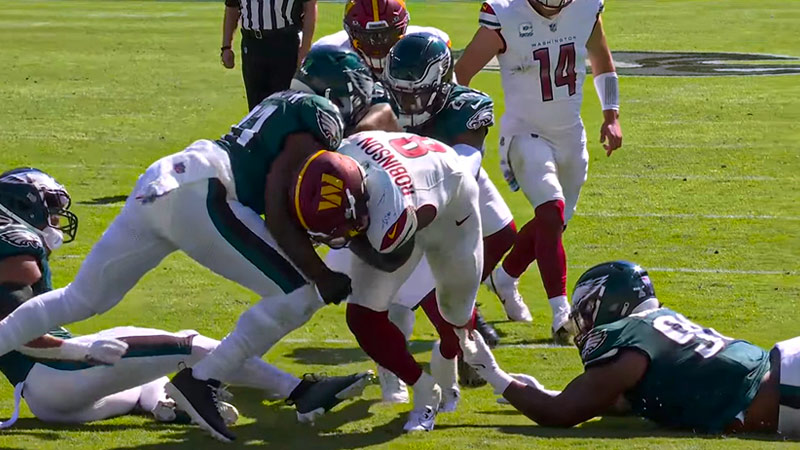In the intricate tapestry of American football, the role of a nose tackle stands out as a linchpin of defensive strategy.
Positioned at the heart of the defensive line, across from the opposing center, the nose tackle wields herculean strength and a formidable physique.
Tasked with halting running backs in their tracks and applying relentless pressure on quarterbacks, the nose tackle is an embodiment of power and precision.
As a linchpin of the renowned 3-4 defensive formation, these behemoths of the gridiron play a pivotal role in disrupting offensive plans, anchoring their team’s defense, and dictating the course of the game.
This is the tale of the unsung hero in the trenches, the nose tackle, in American football.
The Definition of a Nose Tackle in American Football
In American football, the nose tackle is a crucial position within the defensive line. It is a term primarily used in the context of a defensive formation known as the 3-4 defense, although similar roles exist in other defensive schemes as well.
The nose tackle plays a pivotal role in stopping the opposing team’s running game and putting pressure on the quarterback.
Here are some key aspects of the nose tackle position in American football:
Position on the Line
The nose tackle lines up in the center of the defensive line, directly across from the opposing team’s center, who is responsible for snapping the ball to the quarterback.
This position places the nose tackle in a prime location to disrupt the offensive line and create chaos in the backfield.
Physical Attributes
Nose tackles are typically among the largest and strongest players on the field. They need to possess exceptional size and strength to effectively engage with multiple offensive linemen and occupy blockers. Many nose tackles weigh well over 300 pounds and have powerful upper-body strength.
Run Defense
One of the primary responsibilities of a nose tackle is to stop the run. They are tasked with clogging up running lanes and taking on blockers, often drawing double-teams from the opposing offensive linemen.
By doing so, they free up linebackers behind them to make tackles on running backs.
Pass Rush
While nose tackles are primarily known for their run-stopping abilities, they are also expected to contribute to the pass rush.
Some nose tackles possess the quickness and agility to penetrate the offensive line and put pressure on the quarterback. Their ability to collapse the pocket can disrupt passing plays and force hurried throws.
Gap Control
Nose tackles must maintain gap control, ensuring that they do not get pushed out of position by offensive linemen.
They need to stay disciplined and anchor themselves in their assigned gap to prevent running backs from finding open lanes.
Reading the Play
Successful nose tackles have a keen football IQ. They must quickly diagnose the play, whether it’s a run or pass, and react accordingly.
This requires an understanding of offensive line blocking schemes and the ability to react to changing situations in real-time.
Versatility
In some defensive schemes, the nose tackle may be asked to shift between different techniques and alignments, depending on the situation. This versatility allows them to adapt to various offensive strategies.
Teamwork
The nose tackle’s effectiveness often relies on teamwork with the other defensive linemen and linebackers.
They need to communicate well with their teammates to execute stunts, twists and blitzes effectively.
Notable Nose Tackles in NFL History
Throughout the history of the NFL, several nose tackles have left an indelible mark on the league due to their dominance, impact on the field, and contributions to their respective teams.
Here are some notable nose tackles in NFL history:
Damon Harrison

Known as “Snacks,” Harrison has been a dominant force against the run. He played for the New York Jets, New York Giants, Detroit Lions, and other teams, earning Pro Bowl and All-Pro honors for his ability to clog running lanes.
Vince Wilfork
A massive presence on the defensive line, Wilfork played most of his career with the New England Patriots.
His combination of size, strength, and agility made him one of the most formidable nose tackles of his era. He won multiple Super Bowl championships and earned numerous Pro Bowl selections.
Casey Hampton
Hampton, also known as “Big Snack,” was a key contributor to the Pittsburgh Steelers’ defense during their Super Bowl-winning seasons. He was known for his ability to occupy multiple blockers and stuff the run.
Alan Page
While Page is often associated with his time as a defensive tackle for the Minnesota Vikings, he did play some nose tackle during his Hall of Fame career.
His versatility, athleticism, and ability to disrupt offensive lines made him a dominant force in any position on the defensive line.
Ted Washington
Washington was a massive nose tackle who played for several NFL teams during his career, including the Buffalo Bills, New England Patriots, and others. His size and strength made him a formidable run-stopper, and he had a lengthy and successful career.
Joe Klecko
Klecko was a versatile defensive lineman for the New York Jets during the 1980s. He excelled as both a defensive end and a nose tackle and was a key figure in the “New York Sack Exchange,” one of the league’s most feared defensive lines.
Haloti Ngata
Ngata was a dominant force for the Baltimore Ravens and later the Detroit Lions. His combination of size, strength, and athleticism allowed him to control the line of scrimmage and disrupt both the run and the pass. He earned numerous Pro Bowl selections and won a Super Bowl with the Ravens.
Warren Sapp
While primarily known as a defensive tackle, Sapp occasionally played the nose tackle position in certain schemes. He was a disruptive force on the interior of the defensive line and is a Pro Football Hall of Famer.
Nose Tackle’s Impact on the Game

The impact of a nose tackle on the game of American football is substantial and multifaceted. Despite often working in the trenches and away from the spotlight, nose tackles play a crucial role in shaping the outcome of a match.
Here are some key ways in which nose tackles influence the game:
Run Defense
Nose tackles are primarily responsible for defending against the run. Their size, strength, and ability to occupy multiple offensive linemen are vital in plugging running lanes and preventing ball carriers from advancing.
By disrupting the opposition’s rushing attack, nose tackles force teams to become more one-dimensional, relying heavily on passing plays.
Occupying Blockers
One of the most significant contributions of a nose tackle is their capacity to engage with offensive linemen, often drawing double-teams.
By doing so, they free up linebackers and other defenders to make tackles. This not only limits the gains made by the opposing running backs but also allows linebackers to blitz or drop into pass coverage as needed.
Pass Rush
While nose tackles are primarily associated with run defense, some possess the quickness, agility, and technique to contribute to the pass rush.
By collapsing the pocket and pressuring the quarterback up the middle, they disrupt passing plays and can lead to sacks, incomplete passes, or interceptions.
Disrupting Offensive Line Schemes
Effective nose tackles force opposing offensive lines to adjust their blocking schemes. This can lead to confusion, missed assignments, and breakdowns in protection, making it challenging for the offense to execute its plays effectively.
Creating Turnovers
Nose tackles can be involved in creating turnovers by stripping the ball from ball carriers or pressuring quarterbacks into making errant throws. These turnovers can swing the momentum of a game in favor of the team.
Versatility
Some nose tackles are versatile enough to adapt to different defensive schemes and techniques, providing coaches with flexibility in designing their defensive strategies.
They can line up in various positions along the line of scrimmage to exploit weaknesses in the offensive line.
Leadership and Communication
Nose tackles often serve as leaders on the defensive line, guiding their teammates and ensuring everyone is aligned correctly.
Effective communication with linebackers and other defenders helps in making in-game adjustments and reacting to the offense’s changing strategies.
Time of Possession
By disrupting the opponent’s run game and forcing passing situations, nose tackles contribute to controlling the time of possession.
This gives their own offense more opportunities to score and keeps the opposing offense off the field.
Challenges Faced by Nose Tackles

Nose tackles in American football face several unique challenges due to the demanding nature of their position. While they are vital to their team’s defense, their role comes with a set of difficulties that require a unique skill set and mental toughness.
Here are some of the challenges faced by nose tackles:
Double-Teams
Nose tackles often find themselves double-teamed by the opposing center and one of the guards. This means they have to engage and control two offensive linemen simultaneously. Maintaining leverage and strength in these situations can be physically exhausting.
Size and Weight
Nose tackles are typically some of the largest players on the field, which can lead to challenges in terms of conditioning and staying in peak physical shape. Managing their weight and maintaining agility is a constant concern.
Injury Risk
The physicality of the position puts nose tackles at a higher risk of injury. They are often in the middle of the action, absorbing blocks and tackling ball carriers, which can lead to injuries to the knees, ankles, and other parts of the body.
Mental Toughness
Nose tackles must have exceptional mental toughness. They often don’t receive the same recognition as other positions, and their job can be frustrating at times when they’re constantly battling against double teams and dealing with the physical toll of the game.
Reading the Play
Successfully reading and reacting to the offense’s plays is a constant challenge. Nose tackles must quickly diagnose whether it’s a run or pass and respond accordingly, all while battling against offensive linemen.
Changing Offensive Strategies
As offenses evolve and become more pass-oriented, nose tackles must adapt. They may face fewer running plays and more passing situations, which require different skills and strategies.
Versatility
In some defensive schemes, nose tackles are asked to play multiple techniques along the defensive line, which demands versatility. Adapting to different positions and techniques can be challenging.
Sustaining Energy
Nose tackles need to sustain a high level of energy and effort throughout the game. Being a run-stopper and pass-rusher when necessary can be physically demanding over the course of a game that can last several hours.
Leadership
Many nose tackles are expected to be leaders on the defensive line, communicating with teammates, making adjustments, and setting the tone for the entire defense.
Recognition
Nose tackles often receive less recognition and fewer accolades than other positions. Their contributions may not be as visible in the stat sheet, but their impact on the game is significant.
FAQS
Do all NFL teams use a nose tackle in their defense?
No, not all NFL teams employ a nose tackle in their defensive schemes.
Can a nose tackle intercept passes or make interceptions?
Yes, while it’s less common for nose tackles to make interceptions, it’s not impossible.
Do nose tackles have to be exceptionally tall in addition to being large?
No, height is not as critical for nose tackles as size and strength.
Can a nose tackle be moved to another position on the defensive line?
Yes, in some defensive schemes or situations, a nose tackle may be asked to play a different position along the defensive line.
Are there any specific training techniques for aspiring nose tackles?
Aspiring nose tackles often focus on strength training, agility drills, and hand-fighting techniques.
They work on improving their ability to engage with blockers and shed them to make plays in the run game or pass rush.
Wrap Up
In the intricate tapestry of American football, the nose tackle emerges as an unsung hero, embodying the essence of power and precision.
Positioned at the heart of the defensive line, their impact ripples through the game’s fabric, dictating the course of plays and influencing outcomes.
They are the giants who battle in the trenches, absorbing double-teams, disrupting running lanes, and menacing quarterbacks. Despite the challenges and relative anonymity, nose tackles are a linchpin in any formidable defense.
Their mastery of size, strength, and strategy reshapes offenses, making them a vital force in a sport where victory hinges on the subtle dance of power and strategy in the quest for gridiron glory.







